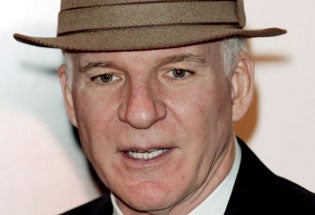Your support helps us to tell the story
From reproductive rights to climate change to Big Tech, The Independent is on the ground when the story is developing. Whether it's investigating the financials of Elon Musk's pro-Trump PAC or producing our latest documentary, 'The A Word', which shines a light on the American women fighting for reproductive rights, we know how important it is to parse out the facts from the messaging.
At such a critical moment in US history, we need reporters on the ground. Your donation allows us to keep sending journalists to speak to both sides of the story.
The Independent is trusted by Americans across the entire political spectrum. And unlike many other quality news outlets, we choose not to lock Americans out of our reporting and analysis with paywalls. We believe quality journalism should be available to everyone, paid for by those who can afford it.
Your support makes all the difference.It sounds like a case for Inspector Clouseau. The actor Steve Martin has been named as a victim in one of the great art scams of recent times, after it emerged that he spent 700,000 euros on a modernist painting which turned out to be faked.
Police in Germany say the Pink Panther star was among dozens of collectors who unwittingly purchased artworks from a prolific group of suspected conmen who were last week charged with creating and then selling 44 forged paintings over the past decade.
Martin was hoodwinked into spending 700,000 euros on an oil painting called “Landschaft mit Pferden” or “Landscape With Horses” in 2004. The piece was authenticated by an expert who said it was created during the First World War by the Dutch artist, Heinrich Campendonk.
He kept the work in his private collection for 15 months, before abruptly deciding to sell it at Christie’s. A Swiss businesswoman took ownership of the painting in February 2006 after bidding 500,000 euros at auction, forty per cent less than Martin originally paid.
It has since been exposed as a colourful creation of Wolfgang Beltracchi and his accomplice Otto Schulte-Kellinghaus, who are accused of creating dozens of fakes which were passsed off as genuine pieces by Campendonk, Max Pechstein, Fernand Léger, Max Ernst, and others.
Martin has not been accused of any wrongdoing in relation to the affair, and says he had no idea that the work was forged. When he bought it from a Paris gallery, it came with both an authentication from an expert art historian and a convincing paper trail charting its ownership over the previous ninety-odd years.
“It wasn’t clear that it was a fake until after Christie’s had sold the picture, it was a long time after that, that it became known,” he told the New York Times today. He added that he was unsure whether he had any legal liability resulting from the sale. “The gallery that sold me the picture has promised to be responsible to me… but it’s still unclear.” Martin is certainly not the sort of wealthy fool one might expect to be easily conned by forgers.
As one of Hollywood’s most prolific collectors, his passion for art was explored in the film LA Story. He once wrote an entire comic novel, Object of Beauty, set in the New York gallery scene.
The whys and wherefores of his decision to offload the painting at a substantial loss during a period when the wider art market was booming remain unclear.
Martin was certainly not the only one to fall victim to the alleged scam, though. To the amazement of the art community, the defendants in the forthcoming case were apparently able to pass their creations off as legitimate by offloading them alongside genuine masterpieces once owned by well-known German collectors.
Among those accused of helping perpetrate the scam are Beltracchi’s wife, Helene and her sister Jeanette, who are said to have claimed that many of the forgeries came from the estate of their late grandfather, a Cologne businsesman called Werner Jägers.
Mr Martin said today that he'd purchased forged works “once or twice” previously, “and each time you become more and more cautious.” But he didn’t suspect that the Campendonk was illegitimate.
“The fakers were quite clever in that they gave it a long provenance and they faked labels, and it came out of a collection that mingled legitimate pictures with faked pictures."
Given that losses from the sale and resale of just 14 of the forged works the forgers put into circulation are said by Berlin prosecutors to have totalled 34.1 euros, Mr Martin may ultimately come to the conclusion that he got off lightly.

Join our commenting forum
Join thought-provoking conversations, follow other Independent readers and see their replies
Comments